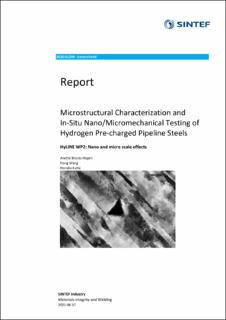| dc.contributor.author | Hagen, Anette Brocks | |
| dc.contributor.author | Wang, Dong | |
| dc.contributor.author | Fathi, Pernille | |
| dc.date.accessioned | 2021-10-27T09:03:03Z | |
| dc.date.available | 2021-10-27T09:03:03Z | |
| dc.date.created | 2020-11-26T14:35:28Z | |
| dc.date.issued | 2020 | |
| dc.identifier.isbn | 978-82-14-06448-3 | |
| dc.identifier.uri | https://hdl.handle.net/11250/2825907 | |
| dc.description.abstract | The hydrogen susceptibility on mechanical properties of a new (Steel A) and a "vintage" (Steel B) X65 pipeline steel, have been investigated by (1) in-situ micromechanical tensile testing and (2) in-situ electrochemical nanoindentation. The tensile samples were extracted from the inner and middle position in longitudinal and transverse direction of the pipe and tested in-situ in a scanning electron microscope (SEM) under four environmental conditions: after 24 -and 96 hours of hydrogen pre-charging, in vacuum (⁓10-5 Pa) (without pre-charging) and in air outside the SEM chamber, for comparison. Nanoindentations were performed on the different microstructures in both Steel A and Steel B. Fractography and SEM characterization techniques such as electron backscatter diffraction (EBSD) and electron channelling contrast imaging (ECCI) analysis were performed to reveal details in both microstructures and hydrogen-related degradation after mechanical tests. | en_US |
| dc.language.iso | eng | en_US |
| dc.publisher | SINTEF Industri | en_US |
| dc.relation.ispartof | SINTEF Rapport | |
| dc.relation.ispartofseries | SINTEF Rapport; | |
| dc.title | Microstructural Characterization and In-Situ Nano/Micromechanical Testing of Hydrogen Pre-charged Pipeline Steels | en_US |
| dc.type | Research report | en_US |
| dc.description.version | publishedVersion | en_US |
| dc.source.pagenumber | 27 | en_US |
| dc.source.issue | 2020:01299 | en_US |
| dc.identifier.cristin | 1853005 | |
| dc.relation.project | Norges forskningsråd: 294739 | en_US |
| cristin.ispublished | false | |
| cristin.fulltext | original | |
